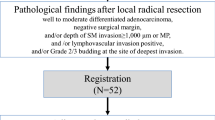Aim:
To evaluate the cytoprotective effect of amifostine against radiation-induced acute toxicity to the rectal mucosa.
Patients and Methods: 36 patients irradiated for prostate or gynecologic cancer were randomized to receive amifostine (n = 18, group A) or not (n = 18, group B). The radiation-induced acute rectal toxicity was evaluated by using three different toxicity scales: WHO scale, EORTC/RTOG toxicity criteria, and a modified toxicity scale based on the LENT-SOMA grading scale and the endoscopic terminology of the World Organization for Digestive Endoscopy. The objective measurements were coming from flexible rectosigmoidoscopy performed at baseline and 1–2 days after completion of the radiotherapy schedule. Anterior-posterior fields were used in the gynecologic patients while 3-D conformal 4-field technique was applied in the prostate cancer patients. The area under the curve (AUC) for dose-volume histograms (DVHs) of the rectum was also assessed during a 3-D treatment planning schedule, and no significant differences were assessed between the two groups, indicating a homogeneous dose-volume effect.
Results: Amifostine was well tolerated. No grade 2 or higher WHO and EORTC/RTOG acute toxicity was noted in group A, while acute rectal toxicity (≥ grade 1) was observed in 16/18 patients of group B versus 2/18 of group A (p < 0.001). The onset as well as the duration of acute rectal toxicity were significantly improved in group A (p = 0.002). Rectosigmoidoscopy revealed more severe rectal mucositis in noncytoprotected patients (group B), and modified LENT-SOMA overall mucositis grading score was significantly lower in group A (p = 0.003).
Conclusion: Amifostine seems to have a significant cytoprotective efficacy in acute radiation-induced rectal mucositis in terms of symptomatic and objective endpoints.
Ziel:
Auswertung der zytoprotektiven Wirkung von Amifostin hinsichtlich der strahlungsinduzierten akuten Toxizität auf die Rektumschleimhaut.
Patienten und Methodik: 36 aufgrund eines Prostata- oder gynäkologischen Karzinoms bestrahlte Patienten nahmen an einer randomisierten Studie teil. Die eine Hälfte (n = 18, Gruppe A) erhielt Amifostin, die andere Hälfte (n = 18, Gruppe B) nicht. Die strahlungsinduzierte akute Toxizität auf die Rektumschleimhaut wurde mit Hilfe von drei verschiedenen Toxizitätsskalen ausgewertet: der WHO-Skala, den Toxizitätskriterien der EORTC/RTOG und einer modifizierten Toxizitätsskala, die sowohl auf der LENTSOMA-Skala als auch auf der endoskopischen Terminologie der Weltorganisation für intestinale Endoskopie beruht. Zu Beginn und 1-2 Tage nach Beendigung der Strahlentherapie wurden mit Hilfe der flexiblen Rektosigmoidoskopie objektive Messungen vorgenommen. Für die gynäkologischen Patienten wurden ventrodorsale Felder benutzt, wohingegen bei den Patienten mit Prostatakarzinom eine 3-D konformale 4-Felder-Technik appliziert wurde. Während des 3-D-Therapieplans wurde auch die Fläche unter der Kurve (AUC) für die Auswertung in rektalen Dosis-Volumen-Histogrammen (DVH) bestimmt. Zwischen den beiden Gruppen war jedoch kein signifikanter Unterschied festzustellen, was auf eine homogene Dosis-Volumen-Wirkung hindeutet.
Ergebnisse: Amifostin war gut verträglich. In Gruppe A wurde der Toxizitätsgrad 2 nach WHO und EORTC/RTOG weder erreicht noch überschritten. In Gruppe A wurde in 16 von 18 Fällen eine akute rektale Toxizität ≥ Grad 1 festgestellt, in Gruppe B dagegen nur in zwei von 18 Fällen (p < 0.001). Bei Gruppe A war hinsichtlich der Zeit bis zum Auftreten der Proktitis sowie deren Dauer eine deutliche Überlegenheit zu verzeichnen (p = 0.002). In der Kontrollgruppe (Gruppe B) deckte die Rektosigmoidoskopie eine wesentlich schwerere Rektumschleimhautentzündung auf, während dir Toxizität entsprechend der modifizierten LENT-SOMA-Skala in der Amifostingruppe bedeutend niedriger war (p = 0.003).
Schlussfolgerung: Amifostin scheint in Anbetracht der beobachteten Symptome, gemessen an objektiven Endpunkten, bei akuter strahlungsinduzierter Proktitis eine zytoprotektive Wirkung zu haben
Similar content being viewed by others
Author information
Authors and Affiliations
Additional information
Received: December 3, 2001; accepted: November 14, 2002
Correspondence Address John R. Kouvaris, MD, Associate Professor of Radiotherapy, 31, Kalampoki Street, Melissia 15127, Athens, Greece, Phone (+30/1) 8033229, Fax 7220253, e-mail: jrkouv@otenet.gr
Rights and permissions
About this article
Cite this article
Kouvaris, J., Kouloulias, V., Malas, E. et al. Amifostine as Radioprotective Agent for the Rectal Mucosa during Irradiation of Pelvic Tumors . Strahlenther Onkol 179, 167–174 (2003). https://doi.org/10.1007/s00066-003-0970-y
Issue Date:
DOI: https://doi.org/10.1007/s00066-003-0970-y




